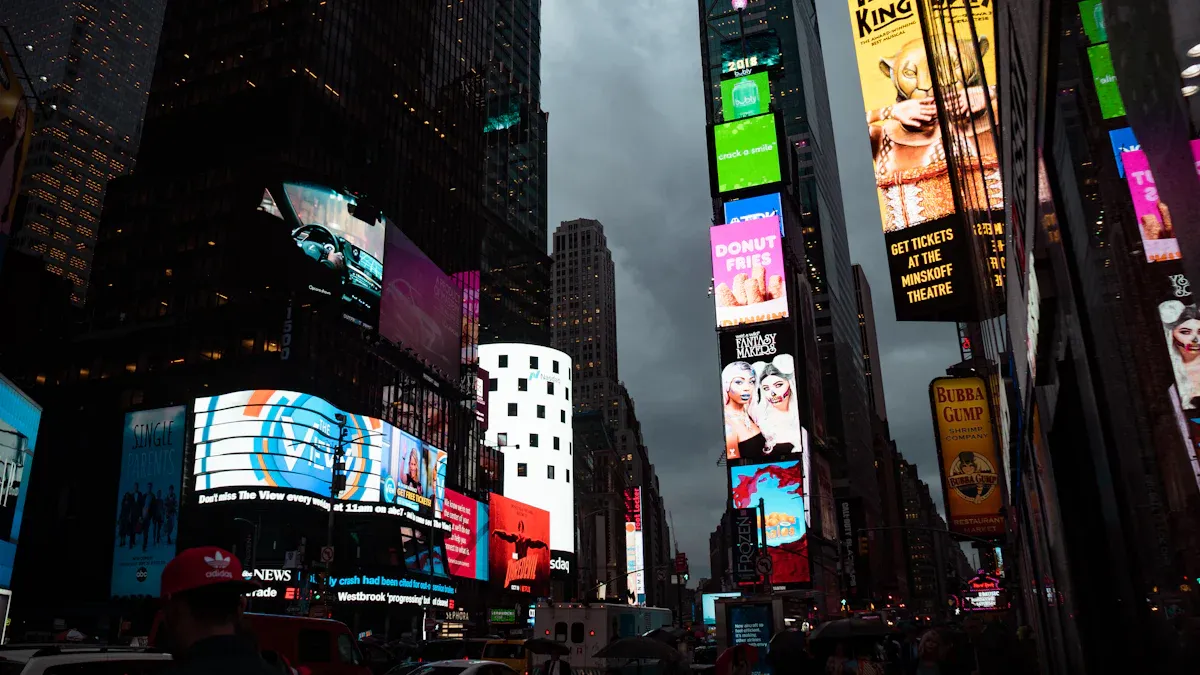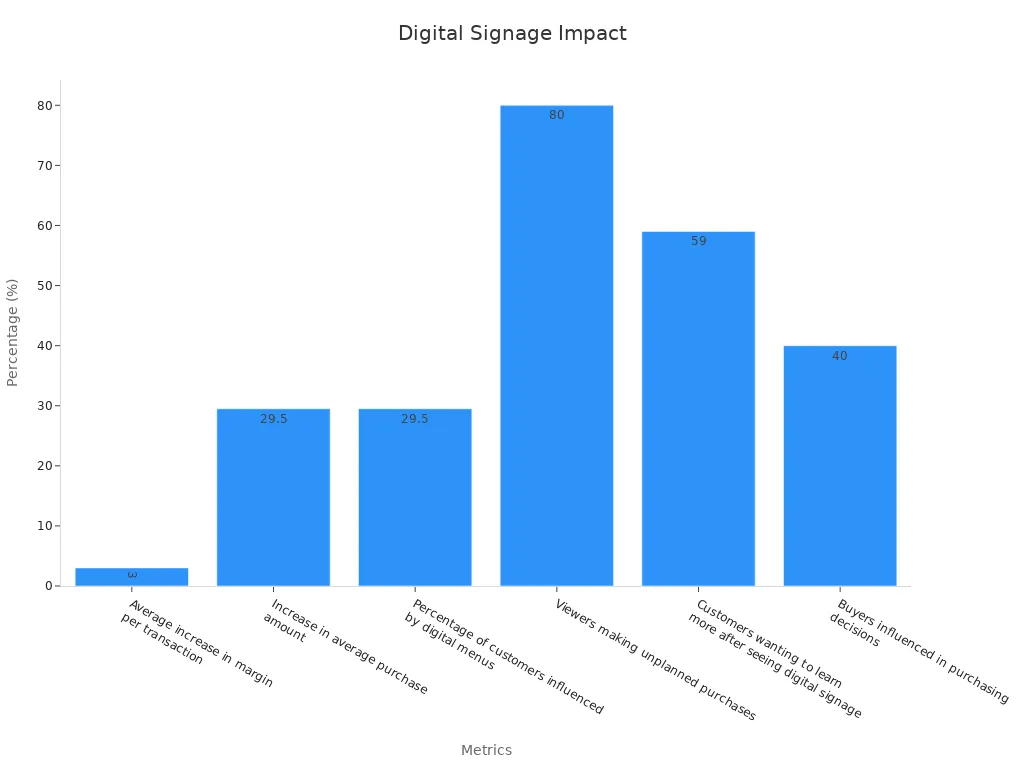Digital Signage Displays: Technology, Benefits, and Implementation Strategies

Digital Signage Displays have transformed the way businesses communicate with their audiences. These screens showcase vibrant images and dynamic content that capture attention effectively. Research indicates that they receive 400% more views than traditional signs. Additionally, they enhance message retention by 83%. In various settings such as stores, hospitals, or hotels, Digital Signage Displays convey updates, promotions, and personalized messages. They also increase customer engagement, with 68% of shoppers making a purchase after viewing a product on a screen. Incorporating Digital Signage Displays into your marketing strategy can elevate customer experiences and create lasting impressions.
Key Takeaways
Digital signs grab attention better, getting 400% more views than old signs and helping people remember messages 83% more.
Touchscreen displays make shopping fun, boosting interest and sales. About 68% of buyers shop after seeing items on screens.
Keeping digital signs updated and fixed makes them work well. The goal is to keep them running 99.9% of the time.
Setting clear goals and knowing your audience is key. This helps you pick the right tools and create good content.
Checking results and changing things based on data makes content better and more useful.
The Technology Behind Digital Signage Displays

Essential Hardware Components
Digital signage needs strong hardware to work well. Screens, media players, and network tools are key parts of this system. Clear, high-quality screens show bright images. Media players send content to the screens. Network tools help update messages quickly, so they stay useful. Good hardware keeps things running smoothly. For example, systems with 99.9% uptime rarely stop working, keeping viewers interested. Regular maintenance, done every month or three months, avoids problems and keeps the system reliable.
Metric | Benchmark | Notes |
|---|---|---|
System Uptime Percentage | 99.9% | Aim for this to keep digital signage reliable. |
Downtime Incidents | <0.1% | Fewer issues mean better audience attention. |
Maintenance Frequency | Monthly/Quarterly | Regular checks stop unexpected breakdowns. |
Software Features and Capabilities
The software in digital signage helps manage and show content. It lets you plan, change, and check content instantly. Special tools like playback reports show if content is shown at the right time. Content stats help you see what works best and improve your plan. Quick updates keep messages new and interesting. The proof-of-play tool tracks when content is shown, helping with rules and checks. These features make digital signage a great way to share information.
Integration of Hardware and Software
Hardware and software must work together for digital signage to succeed. Media players link the software to the screens, making sure content shows smoothly. Quick updates depend on this teamwork to keep messages fresh. Device stats check how hardware is working, and event stats measure how well content performs. Together, these systems create a strong setup that improves communication and keeps people interested. Picking the right parts ensures your digital signage works well and makes a big impact.
Benefits of Digital Signage Displays

Better Customer Experience and Engagement
Digital signage changes how businesses connect with people. It shows bright, fun, and interactive content that grabs attention. Studies say 63% of people notice digital signage, and 59% want to know more about what they see. This makes it a great way to keep customers interested.
Metric | Value |
|---|---|
Global market size prediction | USD 31.71 billion by 2025 |
Increase in in-store happiness | 55% |
Shorter wait time feeling | 25% |
Higher customer satisfaction | 35% |
Interactive screens make shopping better by cutting down wait times. They also make the whole experience more enjoyable. For instance, kiosks make ordering easier, and 79% of people like how simple they are. Letting customers look at menus on their own makes them feel more relaxed and in control.
Tip: Use interactive screens to make personal experiences for your customers. This helps build trust and keeps them coming back.
Better Operations and Lower Costs
Digital signage helps save money and time. It replaces printed signs, cutting printing and delivery costs. Quick updates make sure prices are correct everywhere, saving work hours.
Benefit | Description |
|---|---|
Fast Price Changes | Update prices quickly in many places with less effort. |
Better Operations | Fix problems faster with real-time checks and reports. |
More Customer Interest | Fun content brings more people in and boosts sales. |
Saves Energy | SMD LED screens use less power, lowering bills and lasting longer. |
Easy Management | Control many locations from one place, reducing mistakes and training time. |
Interactive screens also make running a business smoother. Real-time checks and reports keep displays working well. Energy-saving tech like SMD LEDs uses less power and lasts longer. These features make digital signage a smart and eco-friendly choice.
Higher Profits and ROI
Digital signage helps businesses earn more by influencing what people buy. Research shows 80% of viewers buy things they didn’t plan to after seeing digital signage. Companies using these screens have seen sales grow by up to 33%.
Company | What They Did | Results |
|---|---|---|
McDonald's | Used digital menus to improve service and customer experience. | Boosted sales and made customers happier with updated content. |
Nike | Created FuelStation with cool digital displays. | Built stronger customer loyalty and increased sales with fun campaigns. |
Hyatt Regency | Added digital screens for better communication with guests. | Improved service and guest happiness, leading to better results overall. |
Bunnings | Put up big LED screens in stores to engage shoppers. | Plans to earn more from ads and control messages to increase sales. |
Interactive screens also help businesses track data like sales and customer habits. This info helps improve marketing plans. For example, checking daily sales numbers can inspire teams to sell more and do better.

Note: Spending on digital signage not only helps you earn more but also makes your brand stronger in tough markets.
Versatility Across Industries
Digital signage is a helpful tool for many industries. It adjusts to different needs, improving communication and customer experiences while meeting business goals.
Retail
Stores use digital signage to make shopping more exciting. It shows ads, promotions, and fun content that grabs attention. These screens can change how people shop by creating cool spaces. For example, a clothing store might show outfit ideas or popular items to encourage buying.
Hospitality
Hotels, restaurants, and event spaces use digital signage to help guests. It shows maps, schedules, or menus to make visits easier. For instance, a hotel lobby might have a digital map to guide you to a meeting room. This makes guests feel welcome and happy.
Transportation
Airports and train stations use digital signage to share updates. It shows arrival times, delays, and directions to help travelers. These screens make it easier to find your way and reduce waiting stress. They improve the travel experience for everyone.
Corporate
Offices use digital signage to share news and updates with workers. It can show announcements, goals, or team successes. For example, a screen in the breakroom might highlight achievements or upcoming events. This keeps employees informed and motivated.
Education
Schools and colleges use digital signage to share important information. It can show event details, alerts, or learning tools. For instance, a digital board in a hallway might list club meetings or test dates. This helps students and teachers stay updated.
Healthcare
Hospitals use digital signage to guide patients and share health tips. It shows directions, safety messages, or updates in waiting areas. For example, a screen might help patients find the right department or learn about staying healthy. This reduces stress for visitors.
Government
Government offices use digital signage to share news quickly. It can show emergency alerts, announcements, or local updates. For example, a city hall might use a screen to inform people about road closures or events. This helps keep communities informed.
Sector | Uses |
|---|---|
Retail | Shows ads, promotions, and interactive content to engage shoppers. |
Hospitality | Helps with maps, schedules, menus, and guest information. |
Transportation | Shares real-time updates and directions in busy travel hubs. |
Corporate | Displays workplace news, goals, and team achievements. |
Education | Shares campus updates, event info, and learning tools. |
Healthcare | Guides patients, shares health tips, and reduces waiting stress. |
Government | Provides alerts, announcements, and community updates. |
Tip: Match your digital signage to your industry’s needs. This helps you connect better with your audience and get the most out of it.
Digital signage works well in many areas by meeting specific needs. Whether helping customers, guiding travelers, or sharing news, it offers endless possibilities. Using this technology can open new doors and bring success to your business.
Implementation Strategies for Digital Signage
Setting Clear Goals
Before using digital signage, decide what you want to achieve. This helps match your plans with your business needs and audience. Think about your main goal. Do you want to attract more customers, improve marketing, or make work easier? Knowing your purpose helps you choose the right tools and content.
Next, learn about your audience. Think about their age, likes, and habits. For example, younger people might enjoy fun, interactive screens. Older viewers may prefer simple and clear messages.
Follow these steps to set your goals:
Set Your Goals: Decide if you want to boost sales or improve customer happiness.
Plan Your Budget: Figure out costs for screens, software, and upkeep.
Know Your Audience: Study who they are and what they like.
Pick Locations: Choose spots where screens will be seen the most.
Plan Content: Create messages that match your goals and audience.
Real-life examples show why goals matter. Brady Corporation used digital signage to share updates, which improved teamwork and production. Burris Logistics switched to digital displays, making safety tips clearer and workers more connected.
Tip: Clear goals guide your plans and help measure success.
Making Fun and Useful Content
Content is the most important part of digital signage. To grab attention, it should look great and be easy to understand. Start by planning your content. Think about what your audience needs and create messages just for them.
Here are ways to make better content:
Use Great Images: Add sharp pictures and short videos to stand out.
Keep It Simple: Write short, clear messages that are easy to read.
Stay On-Brand: Use your logo, colors, and fonts to match your style.
Add Movement: Include animations or scrolling text to make it lively.
Update Often: Change your content regularly to keep it fresh.
For example, stores can show sales on screens, while restaurants can display menus that change during the day. Touchscreens let customers explore products or services on their own, making the experience more fun.
Note: Good content not only grabs attention but also makes people want to act, like buying something or learning more about your brand.
Picking the Best Tools
Choosing the right tools is key for successful digital signage. Hardware includes screens, media players, and mounts. Software helps you create, schedule, and track content. Pick tools that fit your goals, budget, and needs.
For hardware, think about screen size, quality, and strength. Busy places might need tough screens that don’t glare. Also, pick tools that can grow with your business. This saves money in the long run.
For software, look for features that match your plans. These might include scheduling tools, live updates, and performance tracking. Make sure the software works well with your hardware. Also, think about the total cost, including repairs and upgrades.
Here’s a quick list for choosing tools:
Hardware:
Screen size and picture quality.
Strong enough for the location.
Can grow with your business.
Software:
Easy to use for managing content.
Can update and schedule quickly.
Tracks how well your content works.
Tip: The right tools make sure your digital signage works well and gives great results.
Installation and Technical Setup
Setting up digital signage takes several steps to work well. A good setup helps you reach your goals and connect with your audience. Follow these steps to get started:
Site Assessment
Check the area where you’ll place the screens. Think about how easy they are to see, lighting, and how many people pass by. For example, putting screens at eye level in busy spots gets more attention. Outdoor screens need to handle weather and sunlight glare.Hardware Installation
After picking the spot, set up the equipment. Attach screens securely using strong mounts or stands. Connect media players to the screens and network. Keep cables tidy for a clean look. Outdoor setups need protection from rain and heat.Software Configuration
Install the software after the hardware is ready. Add the content management system (CMS) and link it to your network. Use the CMS to upload and schedule messages. Test the system to make sure the screens show content correctly.Network Setup
A strong network is needed to update content quickly. Wired connections are stable, while Wi-Fi offers flexibility. Protect your system with firewalls and encryption. Check the network often to avoid problems.Testing and Calibration
Test everything before using the system. Check screen brightness, sound, and resolution. Make sure content looks good and changes smoothly. Adjust settings for the best viewing experience. For outdoor screens, increase brightness to fight glare.
Tip: Update your software often to keep your system running smoothly.
Monitoring Performance and Making Adjustments
After your digital signage is working, check how well it’s doing. Use these steps to track results and make changes:
Performance Metrics
Measure how well your signage works. Look at things like how many people interact with it and how often they take action after seeing it. For example, track how many customers use touchscreens or respond to ads. Use the table below to see key metrics:Metric
What It Measures
Audience Engagement Levels
How much viewers interact with the content.
Frequency of Interactions
How often viewers engage with the signage.
Conversion Rates
The percentage of viewers who act after seeing the signage.
Content Reach
How many people see the signage.
Impressions
The number of people exposed to the display.
Gaze-Through Rate (GTR)
The percentage of viewers who look at the content.
Sales Uplift
Combines sales data with signage performance to find trends and boosts in sales.
Monitoring Tools
Use tools to collect data and learn more. Analytics tools count viewers and track how long they watch. Sensors check movement near screens. Logs show how customers use touchscreens. Link sales data to your campaigns to see how they affect revenue. Business intelligence (BI) tools combine this data for a full picture.Continuous Adjustments
Change your content based on what works best. If an ad isn’t getting attention, replace it with something more exciting. Test updates carefully to avoid problems. Roll out changes smoothly and watch their impact. Ask customers and workers for feedback to improve.Process
What It Does
Testing
Makes sure updates work well and don’t cause new issues.
Deployment
Rolls out updates smoothly with help for users during changes.
Monitoring
Checks updates after deployment to confirm they work correctly.
Feedback
Collects ideas from users to improve future updates.
Optimizing Content
Use data to make your content better. For example, if people like videos more than pictures, add more videos. Keep content fresh and interesting to hold attention. Update promotions, announcements, and interactive features often.
Note: Checking and improving your signage is an ongoing process. It keeps your system effective and helps you reach your goals.
By following these steps, you can make your digital signage work its best. Regular checks and updates keep you ahead in a competitive market.
Digital signage screens are a great way to share messages. They show moving content, make work easier, and increase profits. To get the best results, set clear goals and use fun content. Pick the right tools to make your screens work well. Digital signage changes how you talk to people, making messages clear and easy to remember. Using this technology helps your business stay ahead in a busy world. Try digital signage to make things better and achieve success.
FAQ
What is digital signage, and how does it work?
Digital signage shows content like ads or menus on screens. It uses hardware like screens and media players with software to manage and schedule messages. This helps businesses share information and keep people interested.
Can digital signage displays be used outdoors?
Yes, outdoor digital signage works in all weather. These screens are strong and bright, so they stay clear in sunlight or rain. They’re great for ads, directions, or event updates outside.
How do I measure the success of my digital signage?
Check how many people interact with your screens. Look at numbers like impressions, sales increases, and engagement. Use tools to track results and change your content to do better.
Is digital signage expensive to maintain?
No, it saves money over time. Energy-saving screens and remote tools lower costs. Regular checks keep it working well and avoid big repairs. You also save by not printing signs.
What industries benefit the most from digital signage?
Many industries use digital signage, like stores, hotels, and hospitals. It helps share messages, guide people, and make things easier. For example, stores show sales, and hospitals help patients find their way.
See Also
Exploring Different Types and Uses of Poster Display Boxes
Enhancing Storefront Advertising with Effective Window Sign Holders
Boost Your Brand Visibility with Acrylic Light Box Signage
Essential Guide to LED Sign Boxes for Business Owners
Steps for Installing Wall Mounted Signage Holders Professionally

